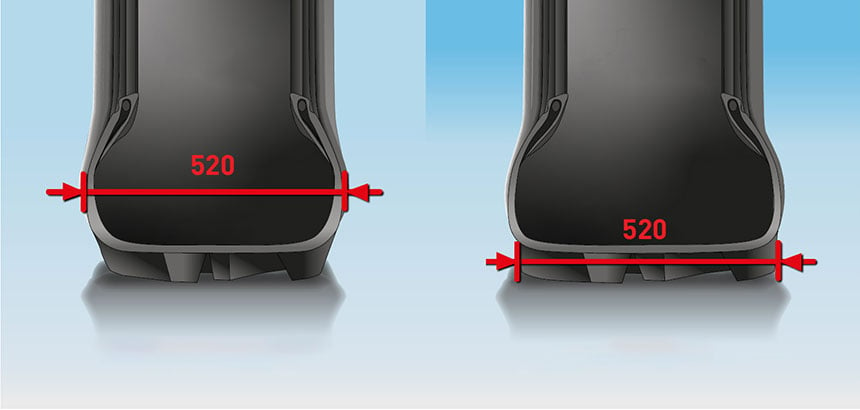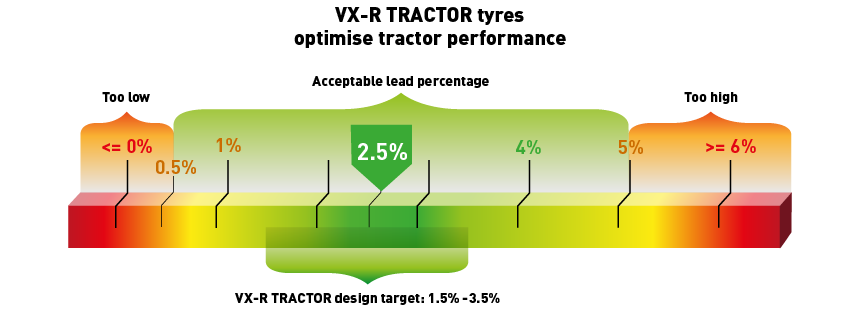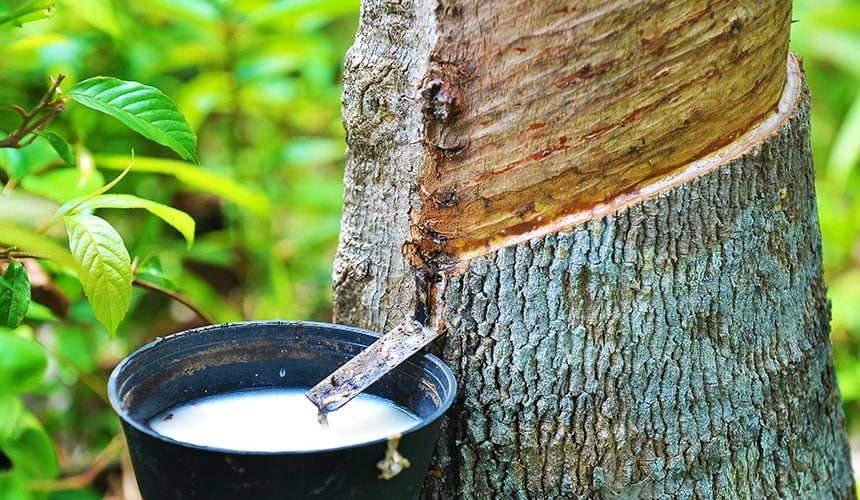You have chosen to apply good crop practices to protect yields on your land on a long-term basis, rather than resorting to intensive farming which depletes your soil.
Sustainable farming takes greater account of all the aspects of your environment; earth, seeds, treatments, machines, fuel and tyres…
When we talk of the environmental impact of agricultural tyres, we tend to think only of recycling the tyres at the end of their lifespan.
Yet there is another aspect that is less common, but much more interesting for you with regard to the environmental impact of your tyres. It’s an aspect that will be good for the environment of course, but also good for you in terms of real financial savings, throughout the wear life of your tyres.
In this article, we explain the research and development work that has been carried out by the Bridgestone group engineers on the development of the VX-R TRACTOR tyre, to expand the concept of environmental impact well beyond the basic ecological aspect.
They have taken into account everything that interacts with the tyre with the aim of obtaining benefits that are shared between the environment and the farmer. A win-win scenario which is kind to the environment, but which helps the farmer save money at the same time.
1. How technology makes it possible to expand the concept of a tyre’s environmental impact
Technology and research on the agricultural environment bring innovative solutions which extend the notion of the environmental impact of tyres well beyond mere C02 emissions.
Bridgestone’s Enliten technology represents a significant breakthrough by completely optimising the manufacture of agricultural tyres to improve their use.

Studying use to improve the product
Starting from their in-depth knowledge of the use of agricultural tyres, the research and development teams have studied tyre design from every angle.
They have taken into account the manufacture of the 4 tyres together, with an optimised rolling circumference between the front axle and the rear axle of the tractor to reduce mechanical strain, a modification of the sections to improve work efficiency, materials selected for their resistance, on a sustainable basis, thus extending agricultural tyre lifespan.
The new tyres stemming from this research reduce not only fuel consumption but also CO2 emissions to limit the environmental footprint in relation to their production.
An environmental impact which includes an economic aspect
All these developments lead directly to savings for farmers, thanks to a reduction in operating costs during daily use.
By choosing tyres with Enliten technology, farmers can not only improve their profitability, but also contribute to a more sustainable management of their equipment, thus ensuring the perennity of their investments.
2. Obtain better traction while demanding less from the engine
Optimisation of traction thanks to a wider tread
The width of the agricultural tyre tread is crucial for optimising traction and tractor performance.
Contrary to common belief, the width indicated on the tyre sidewall does not correspond to the width of the tread in contact with the ground. It corresponds to the section width and in general the tread is not as wide.
For the design of the VX-R TRACTOR, Bridgestone developed a tread width that is as wide as is indicated on the sidewall, which allows more efficient transmission of power to the ground, better traction, and a reduction in slip which saves on engine power.

in contact with the ground, unlike the standard tyre on the left
This wider tread ensures an even spread of the weight, thus reducing soil compaction, a key factor in preserving soil health and improving agricultural yields.
These characteristics not only make it possible to work efficiently, they also limit tyre wear, and therefore extend the tyre lifespan at the same time as reducing tyre replacement costs.
Search for optimal lead to reduce mechanical stress
Incorrect lead can cause irregular tyre wear, excess slip and mechanical transmission problems.
If the lead ratio is too high, the front tyres pull too much, causing rapid wear and extra fuel consumption.
Inversely, with a lead ratio that is too low (lag), it’s the rear tyres that try to go faster than the front tyres, which can lead to overheating of the wheel hubs and additional mechanical strain on the powertrain. This imbalance can damage the front axle pinions, requiring costly repairs.

By fitting your vehicle with tyres with optimal lead settings, farmers not only extend the lifespan of their tyres, but also minimise the mechanical stress faced by their machines, thus reducing maintenance costs and improving the profitability of their agricultural operations.
Positive Environmental Impact and Profitability
By improving traction thanks to a wider tread and by optimising lead, the tyres will contribute to reducing engine solicitation, thus improving productivity while minimising wear and mechanical stress.
These technological innovations contribute towards a more economical management of resources, and therefore have a positive environmental impact. At the end of the day, choosing tyres designed to preserve the engine by reducing mechanical stress leads to more sustainable, more profitable farming.
3. Fight wear better with more enduring materials
A selection of enduring materials for wear resistance
The use of enduring materials makes it possible to reduce the environmental impact.
High quality agricultural tyres use materials that are specifically chosen for their longevity.
For example, the use of natural rubber from Bridgestone’s Hevea tree plantations which are managed on a sustainable basis, mixed with specific plant based oils to replace some of the petrochemical products, offers better resistance to wear, abrasion and impacts.

used for a sustainable management of natural rubber
The compounds used enable the tyres to cope with rigorous working conditions, reducing the risk of sustaining damages and the need for frequent repairs.
This eco-responsible policy, which includes the use of plant based oils instead of chemical products, reduces the environmental footprint while improving tyre performance.
Real savings linked to an extended wear life
Investing in durable agricultural tyres leads to longer tyre wear life, which is beneficial from an economic standpoint.
Although the initial cost of these tyres is higher, their increased longevity means less frequent replacements, so overall costs are reduced in the long run.
In addition, their sturdy construction results in fewer unexpected stoppages for maintenance, improving all round productivity.
At the end of the day, longer lasting tyres have less impact on the environment as they use up less resources, while optimising farm profitability thanks to long-term cost savings.
4. Reduce fuel consumption
What is the direct impact of tyres on fuel consumption
Lower fuel consumption is one of the most important aspects of the environmental impact of agricultural tyres.
Good tyre management can significantly influence fuel costs, which represent around 30% of annual farm costs.
By selecting suitable tyres which minimise rolling resistance, farmers can reduce the amount of fuel required, which leads to a decrease in C02 emissions and a daily reduction of operating costs.

Reduction in slip thanks to the wider tread
A tyre with a wider tread spreads the weight to the ground better, reducing excess slip, which is a key factor in fuel consumption.
A slight amount of slip is necessary to move forwards, but excess slippage not only requires more fuel, it damages the structure of the soil.
By opting for tyres with a larger contact patch with the ground, farmers can improve traction and reduce rolling resistance which means that they will need less fuel.
Optimising lead for better energy efficiency
Optimal lead settings are essential for lower fuel consumption.
Tyres like the VX-R TRACTOR tyre, designed to maintain an ideal lead ratio, ensure that the two axles are synchronised. This avoids scenarios in which incorrect lead causes excessive slippage or inefficient traction, which increases the amount of fuel required.
Better lead settings don’t just reduce fuel consumption, they also extend the lifespan of your equipment, which contributes to more sustainable and more profitable farm management.
5. This win-win strategy in the production of agricultural tyres has led to the development of the VX-R TRACTOR tyre
Bridgestone’s VX-R TRACTOR tyres are designed with a wider tread to maximise the contact area with the ground.
This characteristic provides several key benefits:
- Better traction
The wide tread and the patented "Involute" lug pattern lead to optimal transmission of power to the ground, reducing slip. - Improved driving comfort
The large contact area leads to a more supple driving experience and comfort on the road.

The VX-R TRACTOR tyre design incorporates high quality materials and a reinforced structure to minimise damages.
This sturdiness results in:
- A reduction in maintenance costs
The exceptional durability of the tyres limits interruptions needed for repairs and frequent tyre replacements. - An extended lifespan
Thanks to a compound mix containing plant based oils, these tyres offer greater resistance to wear, which extends their useful life. - Better energy efficiency
Optimal synchronisation of the front and rear axles, thanks to lead management technology, leads to better energy efficiency, thus reducing fuel consumption.

VX-R TRACTOR tyres are improved by the technological advances of Bridgestone’s Enliten label, with its five key elements:
- Reduced environmental impact: use of plant based oils and reduced use of petrochemical products.
- Reduced fuel consumption: less energy loss thanks to the optimal design.
- Mechanical preservation: optimal lead ratio objective.
- Longer lifespan: use of long-lasting materials which extend the tyre wear life.
- Economical production process: more responsible and more sustainable tyre development.

to satisfy the ENLITEN label requirements
CONCLUSION
To conclude, adopting Bridgestone’s VX-R TRACTOR tyres represents a win-win strategy for farmers.
These tyres, designed to last, to save on fuel and be environmentally friendly, not only allow you to reduce operating costs, they also improve farm productivity and sustainability.
The link between a positive environmental impact and better profitability is clearly established thanks to technical innovations which optimise both tyre performance and the management of resources.
By choosing suitable, long-lasting tyres, farmers can contribute actively towards more responsible farming while protecting the economic viability of their farms.
The Bridgestone-agriculture.eu blog is written and administered by tractor tyre experts who are available to provide you with the advice you need on the subject of your agricultural tyres. They allow you to maximise your productivity with information on all subjects linked to tyres: Cheap tractor tyres — Technical data for agricultural tyres — Air pressure advice — Solutions to avoid soil compaction — Sprayer tyre pressure — Why and how to ballast your tractor tyres — When to use dual wheels — The mechanical causes of abnormal wear — Cheap agricultural tyres – etc.
To learn more and boost your farm's profits, Bridgestone-Agriculture is offering you a free, detailed white paper that explains the essential role your agricultural tyres play in your productivity.
Most people who read this article have also read some of the following articles:
- 5 essential techniques to optimise your agricultural tyres
- Impact of the dynamic rolling circumference of agricultural tyres
- What is the impact of the section width of your agricultural tyres
- Do my tractor tyres have a wide enough footprint?
- Can my agricultural tyres help reduce my fuel consumption?
- Does improper lead invalidate your agricultural tyre warranty?
- How can you manage the rolling resistance in agricultural tyres better?
- What are agricultural tyres’ high-strain zones?
- Should you change the rim for wide agricultural tyres?
- Is a premium rim better suited to my tractor tyres?
This information is intended only to make you aware of the technical and functional aspects of agricultural tires and their use. It does not allow you to make a judgment or a definitive conclusion on a given problem. Only your agricultural tire expert is able to make a technical assessment and take a final decision, case by case.
Leave a
commentary
Your email address will not be published.
Required fields are indicated with *








